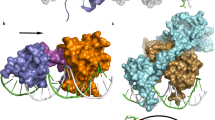Summary
By mutagenizing a λcIts (λcI857) lysogen, a λ mutant has been isolated with a wild-type phenotype. This mutant phage lysogenizes with low efficiency and produces a low burst. Though the initial rates of repressor synthesis in Escherichia coli after infection with wild-type and mutant λ are the same, the maximum level of repressor that is synthesized in the latter case is only about 30% of that synthesized in the former. Virulent λ plates on the lysogen of mutant λ with slightly less efficiency producing very tiny plaques. Operator-binding studies made in vitro with purified mutant and wild-type repressors show that the binding curve of the former repressor is a rectangular hyperbola while that of the latter is sigmoid. The half-lives of the complexes of mutant and wild-type repressors with right operator are 133 and 27 min, respectively. All these results suggest that the mutant repressor possibly has a higher affinity for the operators. This mutant has been named λcIha (ha=high affinity).
Similar content being viewed by others
References
Backman K, Ptashne M (1978) Maximizing gene expression on a plasmid using recombination in vitro. Cell 13:65–71
Chattopadhyay DJ, Mandal NC (1982) Studies on polylysogens containing λN - cI- prophages I. Control of synthesis and maintenance of a large number of integrated λ genomes. Virology 118:439–447
Echols H, Green L (1971) Establishment and maintenance of repression by bacteriophage lambda: The role of the cI, cII, and cIII proteins. Proc Natl Acad Sci USA 68:2190–2194
Herskowitz I, Hagen DI (1980) The lysis lysogeny decision of phage λ: Explicit programming and responsiveness. Annu Rev Genet 14:399–445
Johnson AD, Pabo CO, Sauer RT (1980) Bacteriophage λ repressor and cro proteins: Interaction with operator DNA. Methods Enzymol 65:839–854
Kaiser AD (1957) Mutations in a temperate bacteriophage affecting its ability to lysogenize Escherichia coli. Virology 3:42–61
Kourilsky P (1973) Lysogenization by bacteriophage lambda I. Multiple infections and the lysogenic response. Mol Gen Genet 122:183–195
Lieb M (1966) Studies of heat-inducible lambda bacteriophage I. Order of genetic sites and properties of mutant prophages. J Mol Biol 16:149–163
Lieb M (1976) Mapping missense and nonsense mutations in gene eI of bacteriophage lambda: marker effects. Mol Gen Genet 146:285–290
Lin ECC, Lerner SA, Jorgensen SE (1962) A method for isolating constitutive mutants for carbohydrate-catabolizing enzymes. Biochim Biophys Acta 60:422–424
Miller HI, Kikuchi A, Nash HA, Weisberg RA, Friedman DI (1978) Site-specific recombination of bacteriophage λ: The role of host gene products. Cold Spring Harbor Symp Quant Biol 43:1121–1126
Oppenheim AB, Noff D (1975) Deletion mapping of trans-dominant mutations in the λ repressor gene. Virology 64:553–556
Oppenheim AB, Gottesman S, Gottesman M, (1982) Regulation of bacteriophage λ int gene expression. J Mol Biol 158:327–346
Pabo CO, Sauer RT, Sturtevant JM, Ptashne M (1979) The λ repressor contains two domains. Proc Natl Acad Sci USA 76:1608–1612
Pfhal M (1979) Tight-binding repressors of the lac operon: Selection system and in vitro analysis. J Bacteriol 137:137–145
Pfahl M (1981) Characteristics of tight-binding repressors of the lac operon. J Mol Biol 147:1–10
Ptashne M, Jeffrey A, Johnson AD, Maurer R, Meyer BJ, Pabo CO, Roberts TM, Sauer RT (1980) How the repressor and cro work. Cell 19:1–11
Sauer RT, Pabo CO, Meyer BJ, Ptashne M, Backman KC (1979) Regulatory functions of the λ repressor resides in the amino terminal domain. Nature 279:396–400
Sly WS, Rabideau K, Kolber A (1971) The mechanism of lambda virulence II. Regulatory mutations in classical virulence. In: Hershey AD (ed) The bacteriophage lambda. Cold Spring Harbor Laboratory, New York, p 575–588
Sussman R, Jacob F (1962) Sur un systeme de repression thermosensible chez le bacteriophage d'Escherichia coli. CR Acad Sci (Paris) 254:1517–1519
Zinder ND (1960) Sexuality and mating in Salmonella. Science 131:924–926
Author information
Authors and Affiliations
Additional information
Communicated by W. Arber
Rights and permissions
About this article
Cite this article
Nag, D.K., Chattopadhyay, D.J. & Mandal, N.C. Structure and function of the repressor of bacteriophage lambda. Molec. Gen. Genet. 194, 373–376 (1984). https://doi.org/10.1007/BF00425547
Received:
Issue Date:
DOI: https://doi.org/10.1007/BF00425547




